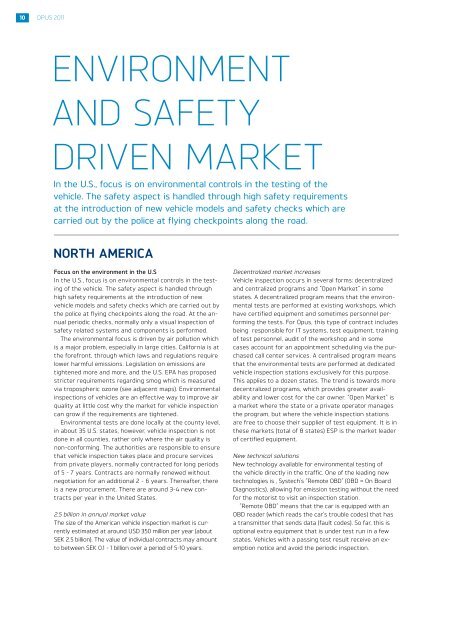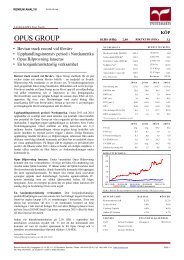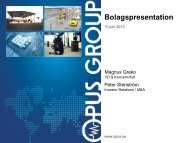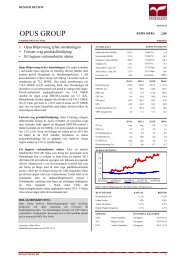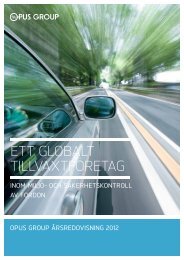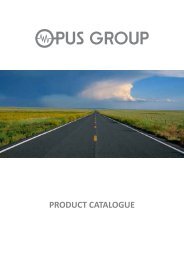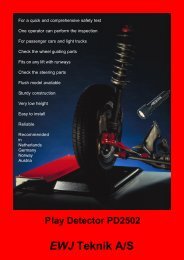Opus Group Annual 2011 Report ENG
Opus Group Annual 2011 Report ENG
Opus Group Annual 2011 Report ENG
You also want an ePaper? Increase the reach of your titles
YUMPU automatically turns print PDFs into web optimized ePapers that Google loves.
10<br />
OPUS <strong>2011</strong><br />
ENVIRONMENT<br />
AND SAFETY<br />
DRIVEN MARKET<br />
In the U.S., focus is on environmental controls in the testing of the<br />
vehicle. The safety aspect is handled through high safety requirements<br />
at the introduction of new vehicle models and safety checks which are<br />
carried out by the police at flying checkpoints along the road.<br />
NORTH AMERICA<br />
Focus on the environment in the U.S<br />
In the U.S., focus is on environmental controls in the testing<br />
of the vehicle. The safety aspect is handled through<br />
high safety requirements at the introduction of new<br />
vehicle models and safety checks which are carried out by<br />
the police at flying checkpoints along the road. At the annual<br />
periodic checks, normally only a visual inspection of<br />
safety related systems and components is performed.<br />
The environmental focus is driven by air pollution which<br />
is a major problem, especially in large cities. California is at<br />
the forefront, through which laws and regulations require<br />
lower harmful emissions. Legislation on emissions are<br />
tightened more and more, and the U.S. EPA has proposed<br />
stricter requirements regarding smog which is measured<br />
via tropospheric ozone (see adjacent maps). Environmental<br />
inspections of vehicles are an effective way to improve air<br />
quality at little cost why the market for vehicle inspection<br />
can grow if the requirements are tightened.<br />
Environmental tests are done locally at the county level,<br />
in about 35 U.S. states, however, vehicle inspection is not<br />
done in all counties, rather only where the air quality is<br />
non-conforming. The authorities are responsible to ensure<br />
that vehicle inspection takes place and procure services<br />
from private players, normally contracted for long periods<br />
of 5 - 7 years. Contracts are normally renewed without<br />
negotiation for an additional 2 - 6 years. Thereafter, there<br />
is a new procurement. There are around 3-4 new contracts<br />
per year in the United States.<br />
2.5 billion in annual market value<br />
The size of the American vehicle inspection market is currently<br />
estimated at around USD 350 million per year (about<br />
SEK 2.5 billion). The value of individual contracts may amount<br />
to between SEK 0.1 - 1 billion over a period of 5-10 years.<br />
Decentralized market increases<br />
Vehicle inspection occurs in several forms: decentralized<br />
and centralized programs and ”Open Market” in some<br />
states. A decentralized program means that the environmental<br />
tests are performed at existing workshops, which<br />
have certified equipment and sometimes personnel performing<br />
the tests. For <strong>Opus</strong>, this type of contract includes<br />
being responsible for IT systems, test equipment, training<br />
of test personnel, audit of the workshop and in some<br />
cases account for an appointment scheduling via the purchased<br />
call center services. A centralised program means<br />
that the environmental tests are performed at dedicated<br />
vehicle inspection stations exclusively for this purpose.<br />
This applies to a dozen states. The trend is towards more<br />
decentralized programs, which provides greater availability<br />
and lower cost for the car owner. ”Open Market” is<br />
a market where the state or a private operator manages<br />
the program, but where the vehicle inspection stations<br />
are free to choose their supplier of test equipment. It is in<br />
these markets (total of 8 states) ESP is the market leader<br />
of certified equipment.<br />
New technical solutions<br />
New technology available for environmental testing of<br />
the vehicle directly in the traffic. One of the leading new<br />
technologies is , Systech’s ”Remote OBD” (OBD = On Board<br />
Diagnostics), allowing for emission testing without the need<br />
for the motorist to visit an inspection station.<br />
”Remote OBD” means that the car is equipped with an<br />
OBD reader (which reads the car’s trouble codes) that has<br />
a transmitter that sends data (fault codes). So far, this is<br />
optional extra equipment that is under test run in a few<br />
states. Vehicles with a passing test result receive an exemption<br />
notice and avoid the periodic inspection.


